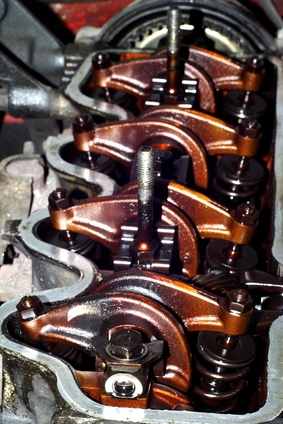
During the engine-rebuilding process, it's paramount to use lots of assembly lube on things such as the camshaft and lifters. However, one place you don't want oil is between the machined surfaces of the connecting rod and cap. Oil there causes erroneous torque readings of the rod bolt. When the trapped oil burns away, connecting rod bolts loosen up and cause catastrophic failure. Lubrication is still the most crucial issue when starting an engine after rebuilding it. Lubricate the engine by priming it before starting. Also be sure the engine is ready to run for 30 minutes.
Connect a mechanical oil pressure gauge to the engine, even if it's just used in a temporary situation. The mechanical oil pressure gauge can be connected to the tapped threaded hole where the engine's electronic sending unit is installed. The mechanical gauge is much more accurate than an electronic sending unit for an electronic gauge or an oil light and should be used when starting a rebuilt engine.
Unplug the distributor located on the top side of a V-8 engine or on the side of an inline engine, so the engine will not start while rotating the crankshaft. Loosen but don't remove the number one spark plug from the cylinder.The number one spark plug varies with different manufacturers; consult the engine service manual for the specific engine to locate the number one spark plug. Find the 0-degree line marked on the crankshaft balancer. The balancer is connected to the front of the crankshaft and is behind the engine's bottom pulleys. Bump the starter in short bursts by just cranking the engine for a split second. Listen for compression noises near the number one spark plug. After hearing compression leak from the loose spark plug, align the 0-degree line on the crankshaft balancer with the timing tab on the timing chain cover by bumping or rotating the engine in the same direction as the starter turns it.
Remove the distributor cap from the distributor. Make a mark on the distributor housing that aligns with the rotor cap pointer. The pointer should be pointed at the number one spark plug tower in the cap. If not, be sure the engine did not pass the compression stroke and the distributor was installed correctly. Make another mark on the distributor base flange housing and a corresponding one on the intake manifold.
Loosen and slide the distributor hold-down clamp back. Lift the distributor out of the intake. Shine a flashlight down into the distributor hole. Notice the flat groove in the oil pump shaft. A Chevy engine was used as example here; check your specific engine for oil priming instructions.
Remove the valve covers from the engine. Pour a half quart of oil over the lifters just prior to starting the engine.
Insert an oil pump priming rod into a 1/2-inch drill motor. Slide the flat blade of the priming tool into the pump rod groove, which is located inside the distributor hole. Rotate the drill motor in a clockwise rotation, start the drill and prime the oil pump. Monitor the oil pressure gauge to be sure that oil pressure is building and reaches at least 30 psi. Prime the engine for 10 minutes. Note if oil also reaches the rocker arms on all cylinders.
Reinstall the distributor by aligning the rotor button pointer with the corresponding mark on the housing and realign the other mark on the housing with the intake manifold. With the timing marks aligned, the rotor should be aimed at the number one spark plug tower in the distributor cap on the compression stroke. Tighten the number one spark plug. Reconnect the distributor plug. Reinstall the valve covers.
Turn the key on for 20 seconds and then off for 20 seconds. This cycles the fuel pump to send fuel to the engine so there will be sufficient fuel to start the engine without excess cranking. Excess cranking on a newly rebuilt engine can cause damage to the engine. Cycle the key several times to allow fuel into the fuel injection system; then start the engine. If the engine is equipped with a mechanical fuel pump, spray a small burst of starting fluid into the carburetor so the engine does not crank needlessly to pump fuel into the carburetor. Starting fluid will help avoid unnecessary engine cranking.